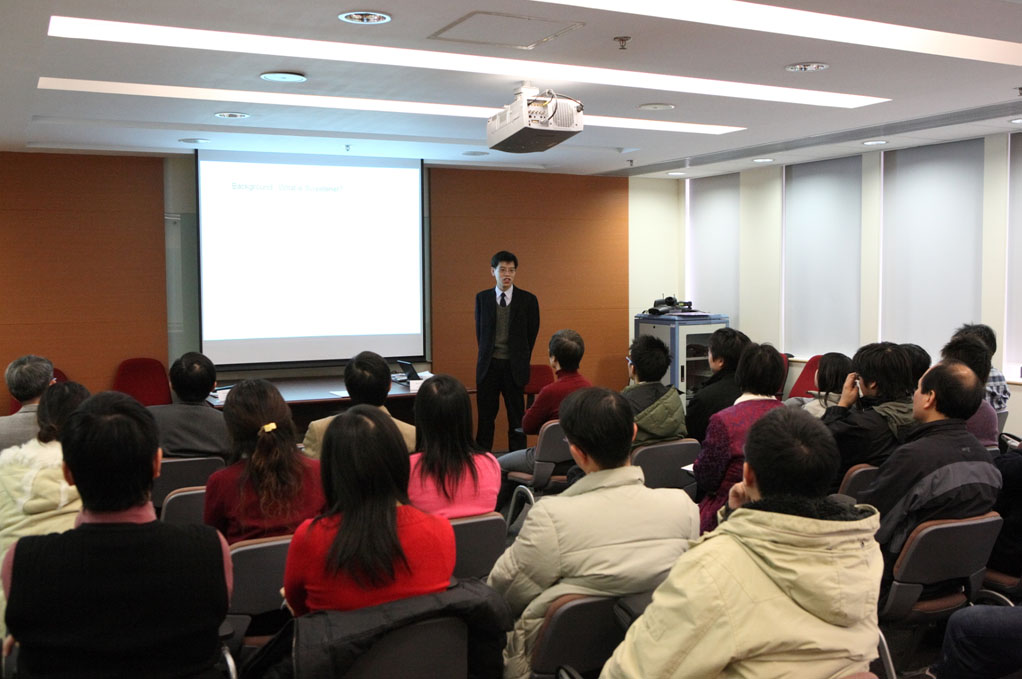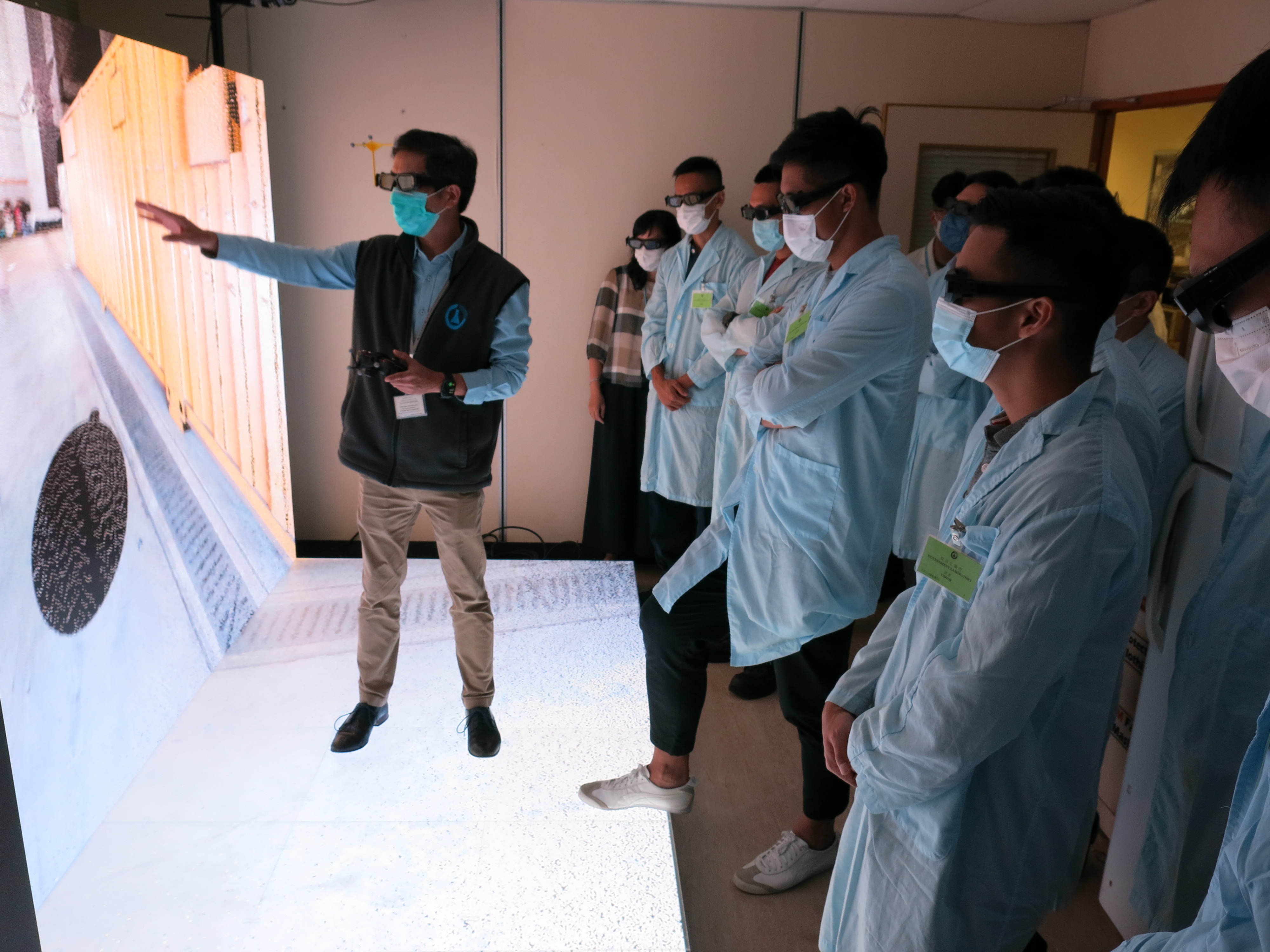Training and Development Collaborations
The Government Laboratory (GL) is committed to contributing to the sustainable development of measurement science and scientific infrastructure in Hong Kong by fostering collaborations and positive partnerships with counterparts, professional organisations and client departments involving in scientific investigations.
Technical exchange
GL often organizes talks and seminars to facilitate the local testing sector in building their testing capabilities and preparing for laboratory accreditation to ISO/IEC 17025.
Briefing sessions
Over the years, GL continued organizing technical seminar for the commercial sector to provide a platform for technical exchange. Among others, more than 25 briefing sessions on food testing covering determination of preservatives, veterinary drug residues, pesticide residues, food additives, food dyes, toxins, etc had been organized since 2005. These briefing sessions provided opportunities for GL to share its experience with local commercial laboratories and enhance their interests in the provision of food testing service.

Technical seminar for commercial testing sector
Test methods
Abstracts of analytical methods presented in the briefing sessions which are related to outsourcing activities are provided below for reference.
Aflatoxins B1, B2, G1 and G2 in general food are extracted with 70% methanol and then purified by immunoaffinity column. The purified extract is then analysed using High Performance Liquid Chromatography (HPLC) with post-column derivatization with iodine or photochemical derivatization techniques. The extraction and clean-up method for aflatoxin M1 depends on the food types. Aflatoxin M1 in cheese, butter or ice-cream sample is extracted with chloroform. The extract is then dried and concentrated. The concentrated extract is cleaned up by passing through a silica solid phase extraction (SPE) cartridge. Aflatoxin M1 in liquid milk or milk powder sample is simply defatted prior to cleanup by a specific immunoaffinity column, and the concentration of aflatoxin M1 is then determined by HPLC using a C18 column and detected by a fluorescence detector. Liquid Chromatography – Tandem Mass Spectrometry (LC-MS/MS) is also used as an alternative technique for quantitation.
In the qualitative test, sample solutions are acidified and tested with turmeric paper. The presence of borate is indicated by the turning of turmeric paper from yellow to red. This method provides a rapid screening test for the compound. In the quantitative test, the sample is ashed and then dissolved in dilute hydrochloric acid. The resultant solution is allowed to react with azomethine H which forms an intense yellow colour with boron. The developed colour, which is proportional to the amount of boron present, is measured at 420 nm by spectrophotometer. For further confirmation, the amount of boron expressed as boric acid, after microwave-assisted acid digestion, can be determined by Inductively Coupled Plasma – Optical Emission Spectroscopy (ICP-OES).
The sample is steam distilled and the distillate is analysed by Gas Chromatography with Flame Ionisation Detecter (GC-FID) after acidification with formic acid. Butyric acid is used as internal standard.
Nitrite and nitrate in meat and meat products are extracted by borax solution with the addition of activated charcoal and Carrez solutions. The determination of nitrite is based on its reaction with sulphanilamide and N-(1-naphthyl)ethylenediamine in forming a red azo dye. The dye formed is measured at 540 nm by Flow Injection Analysis (FIA). Nitrate content is obtained by the difference of the total nitrite after reduction by the use of a cadmium column and the nitrite content by bypassing the cadmium reduction column. Further quantitative confirmation for non-compliant sample can be done by Ion Chromatography with Ultra-Violet detection (IC-UV) with reference to BS EN 12014-4:2005.
The determination of nitrite and nitrate in milk and milk products is referenced to BS EN ISO 14673-3:2004.
The sample is first homogenized and spiked with internal standards Sudan I-d5 and Sudan IV-d6. The Sudan dyes and related dyes are then extracted by acetonitrile. Any dye present is detected by LC-MS/MS.
Melamine in the food sample is dissolved in water and then washed with dichloromethane. Solid phase extraction using MCX column may be employed to further clean-up the extract to achieve lower detection limit if required. The final extract with isotopically-labelled internal standard is then analyzed by LC-MS/MS.
The determination of Sulphur dioxide in various food samples are referenced to AOAC 975.32, AOAC 961.09, AOAC 990.28 and AOAC 990.29, whenever applicable.
The method is for the simultaneous determination of the preservatives in starchy food, meat products and beverage. The preservatives are extracted from food with 70% acidified ethanol and their concentrations are determined by HPLC using a C18 column.
Method 1: The preservatives in comminuted food are extracted by steam distillation in an acidic medium. Benzoic acid and sorbic acid are measured by HPLC using a C18 column and with ultraviolet detection at 272 nm and 254 nm respectively.
Method 2: Benzoic acid and sorbic acid are isolated from food samples by extraction with diethyl ether, followed by successive partitioning into aqueous sodium hydroxide. The aqueous extract is then acidified and re-extracted by dichloromethane. Subsequently, the preservatives are converted to trimethysilyl (TMS) esters and determined by GC-FID. The presence of the preservatives is also confirmed by gas chromatography with mass spectrometry (GC-MS). Phenylacetic acid and caproic acid are used as internal standards for benzoic acid and sorbic acid respectively.
In the testing of pesticide residues in food, reference would be made to national or international technical criteria and reference testing methods depending on the actual requirements, equipment and resources available. Multi-residues test methods are now commonly employed for the determination of pesticide residues for a wide variety of foodstuffs. QuEChERS method is one of the widely used extraction and cleanup procedure due to its simplicity and effectiveness. For instrumental analysis, multi-classes pesticide residues can be technically divided into GC-amenable and LC-amenable analytes which are detected by GC or LC coupled with tandem mass spectrometers accordingly.
The target analytes in food samples generally include Antimony (Sb), Arsenic (As), Cadmium (Cd), Chromium (Cr), Lead (Pb), Mercury (Hg) and Tin (Sn). The food samples are homogenised and then digested with nitric acid under microwave-assisted digestion conditions. The digested samples are subsequently diluted with water and the amounts of metals are determined by Inductively Coupled Plasma - Mass Spectrometry (ICP-MS).
Inorganic arsenic in homogenised food sample is extracted with dilute nitric acid and hydrogen peroxide at elevated temperature. The extract is then analysed by Ion Chromatography coupled with ICP-MS.
Methylmercury in fish sample is extracted with cysteine or mercaptoethanol solution. The extract is then analysed by HPLC coupled with ICP-MS.
Training Engagements
By actively engaging in international seminars, forums and research committees, we have maintained a visible presence in the scientific arena and positive partnerships with professional bodies from all over the world. We have presented and published research papers to promote knowledge sharing. Furthermore, we have established solid networks with our counterparts through visits and attachments.
To help build the scientific infrastructure and to promote the use of science in serving the public, we conduct relevant courses, lectures and briefings for the Hong Kong Police Force, Customs and Excise Department, Immigration Department, Fire Services Department, Correctional Services Department; specialised courses in areas such as Traffic Accident Investigation, DNA Buccal Swab Collection, Criminal Investigation, Fire Investigation, etc. are organised to meet the specific learning needs, in light of the work contexts and duties of participants.

Training Course for other government departments
Customized briefings on relevant scientific subjects have also been conducted for departments such as Social Welfare Department, Department of Health and Department of Justice to provide participants with continuous learning opportunities for enriching their work-related scientific knowledge.


